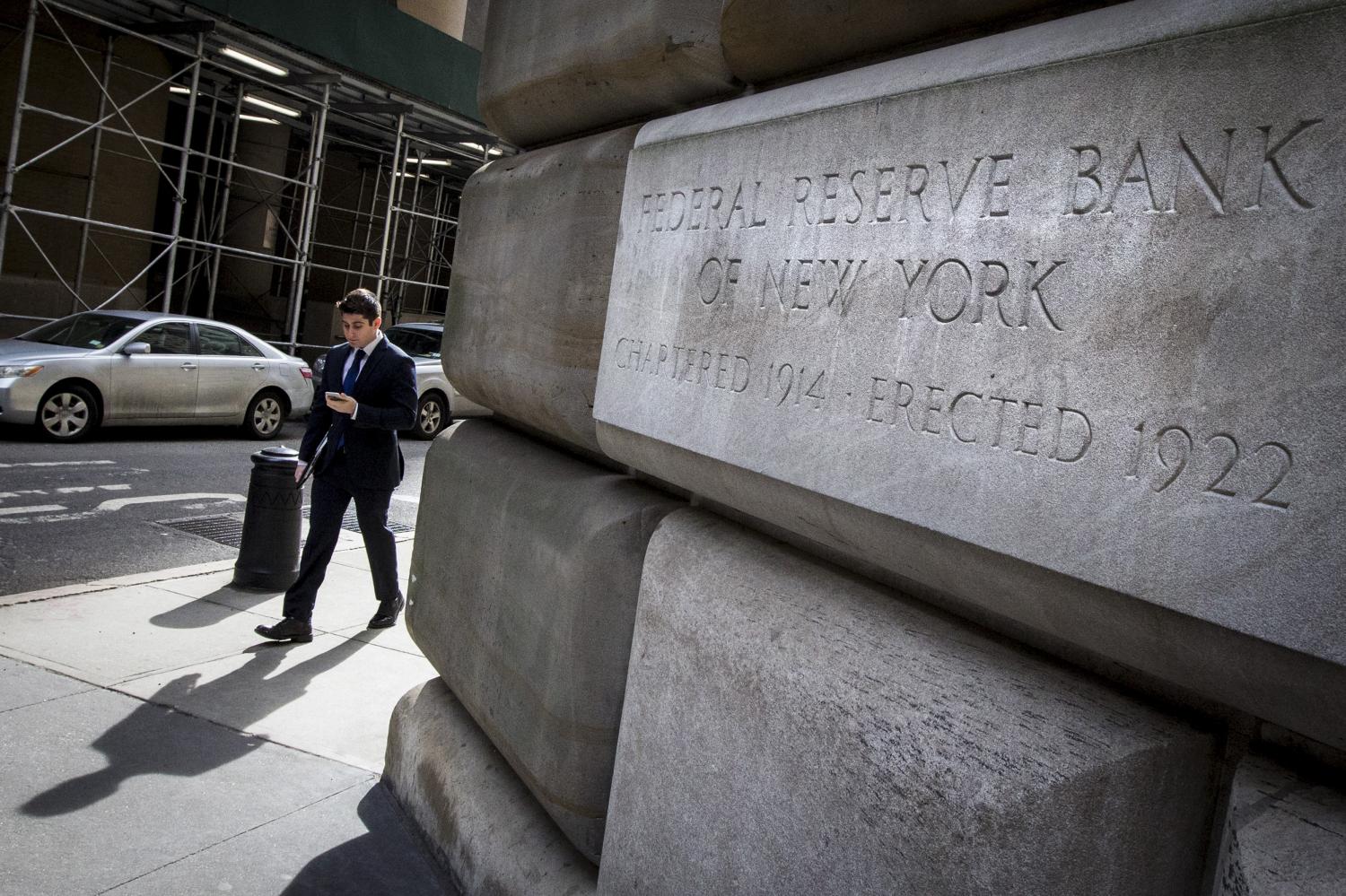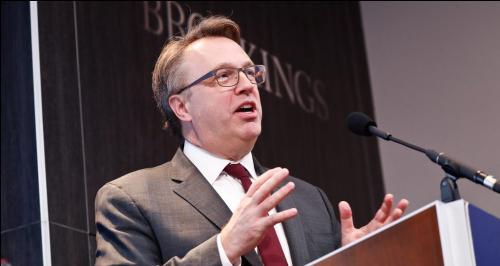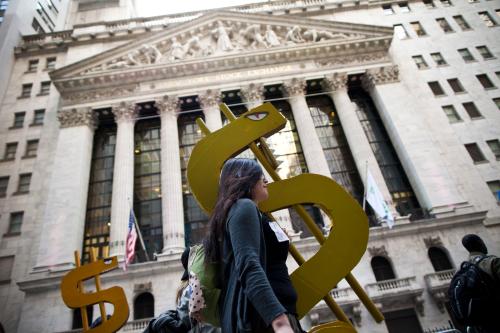This report is part of the Series on Financial Markets and Regulation and was produced by the Brookings Center on Regulation and Markets.
After a somewhat controversial search, the New York Fed announced in April that it had chosen the economist John Williams as its new president. From one perspective, Williams is a superb choice. His last job was as president of Federal Reserve Bank of San Francisco, giving him ample experience within the Fed. And he has been an intellectual leader in shaping the monetary policy climate in a period of substantial uncertainty. He even has bipartisan bona fides: Republican Fed critic John Taylor was his dissertation adviser at Stanford and remains a strong supporter. Janet Yellen, the former Fed Chair appointed by Democrat Barack Obama, was his boss at the San Francisco Fed in the 2000s. In a statement released just after the New York Fed’s announcement, Yellen1 “strongly support[ed]” the move and described Williams as “a distinguished economist who has made major contributions to the formulation of monetary policy.”
Dig a little deeper, though, and Williams’s appointment raises more questions than it answers. Despites his impressive qualifications, he already was a central banker within the Federal Reserve System. Why, then, should he move to New York? While this isn’t the first time we’ve seen one Federal Reserve Bank president decamp to lead another—Gerald Corrigan moved from the Minneapolis Fed to the New York Fed in the early 1980s—it is worth exploring what makes the New York Fed presidency unique and whether Williams was the best choice given these unique features.
The New York Fed’s role in the Federal Reserve System
Some historical context is useful. For most of what I have elsewhere called the First Federal Reserve System, to lead the New York Fed was to lead the Federal Reserve System itself. The First Federal Reserve System, created in 1913 and effectively abolished in 1935, left legal ambiguity as to the center of power between the quasi-private Reserve Banks scattered unevenly throughout the country and the political Federal Reserve Board, located in the U.S. Treasury in Washington (and chaired by the Treasury Secretary). Benjamin Strong, Wall Street’s leading candidate to lead the new central banking system, became Governor of the New York Fed and resolved that ambiguity by dint of personality and his powerful contacts. New York, despite protests from some corners of the new system, would be the center of gravity.
As it did with so much else, the Great Depression changed everything. In 1935, as part of what historians have called the Second New Deal, the Roosevelt Administration reformed the Federal Reserve System and placed a newly constituted Board of Governors in Washington as the unquestioned political, operational, and legal center of authority. But even then, a tussle for power between the Board and the New York Fed continued. Allan Sproul, president of the New York Fed from 1941 – 1956, was considered by many the dominant central banker of his day. By the mid-1950s, the New York Fed had taken its rightful place as the junior central banking partner to the Fed Chair. Except perhaps for a brief period in the 1970s when Paul Volcker led the New York Fed and the hapless G. William Miller tried (and failed) to lead at the Board of Governors, Washington has dominated the Federal Reserve System. This is not only true in relation to the New York Fed, but the other twelve Federal Reserve Banks, too.
The dominance of the Fed’s Board of Governors tells us something about the relationship between it and the Reserve Banks, but what of the New York Fed to the other eleven Reserve Banks? Here the relationship is more complicated. Because of its geography and the banks within its district, the New York Fed is indeed unique, with distinctions in law and practice not shared by the rest of the system. Any claim, then, that Williams’s move from San Francisco to New York represents a valuable change to Fed governance depends on what Williams can do with those differences. In other words, we already had Williams as a central banker. What does the public gain by having him be the central banker in New York?
Evaluating Williams against the main job criteria
To evaluate that question, we need to look at the Fed’s three main functions and the way the New York Fed interacts with each: 1) creating and implementing monetary policy 2) creating system-wide financial policy (also known as regulation), and 3) overseeing individual institutions within the system (also known as supervision).
From the perspective of creating monetary policy, the New York Fed presidency should not be regarded as having status of particular importance. This is a provocative statement. The President of the New York Fed sits as the only Reserve Bank with a permanent vote on the Fed’s Federal Open Market Committee, its principal monetary policy-making committee. He—and it has, infamously, always been a he—is also by tradition the committee’s Vice Chair.
But again, he was already well-positioned to make these contributions from his perch in San Francisco. Despite rotating every third year with Minneapolis and Kansas City, the San Francisco Fed president always attends these meetings, making his or her views, research, and arguments available to the rest of the committee. And presence alone, even without the vote, is arguably what matters for shaping monetary policy. This exceptionally important committee doesn’t operate like other prominent policy committees in our government, such as congressional committees or the Supreme Court. Formal dissents are vanishingly rare, less than one per meeting on average (out of twelve potential votes).
Voice, then, is everything. Reserve Bank presidents have, over time, become much more vocal relative to Governors in FOMC meetings. Figure 1 illustrates this phenomenon by measuring the number of times an FOMC member—Governor (excluding Chair) and Reserve Bank president, voting and nonvoting—is mentioned per the transcripts of meetings going back to 1980. In the 1980s and early 1990s, the Governors were more dominant; the trend has reversed since then and accelerated since the 2008 financial crisis.
Figure 1: Meeting Participation by FOMC Members, 1980 – 2012
Source: Board of Governors of the Federal Reserve System. Number of times FOMC members’ names are mentioned in the FOMC transcripts since 1987. The Y-axis is taken from the average number of times each individual FOMC participant excluding chairs is mentioned by category (Governor, Voting President, Nonvoting President), divided by the number of overall mentions per meeting, giving a participation percentage for each meeting, p=95%. My thanks to Andrew Baker for creating these graphs and Qasim Iqbal for research assistance.
Figure 2 illustrates the differences between the New York Fed, the other Voting Reserve Bank presidents, and the non-voting presidents. Here, voting status certainly matters, although the permanent vote that only New York enjoys does not, at least not since the mid-2000s. Much of this is driven by personality: New York Fed president Anthony Solomon dominated FOMC meetings during his time in the 1980s; William McDonough, his successor, did not. The scale of these graphs shouldn’t be misread to overstate the differences: while voting Reserve Bank presidents do speak more often than non-voting presidents, it’s a marginal difference if there is even a difference to observe at all, since variations we do observe are often not statistically significant. Over this period, for example, voting presidents spoke on average eighteen times per meeting, while non-voting presidents spoke on average fifteen times. Whatever influence Williams had as a central banker in shaping the monetary policy-making space isn’t dramatically changed by switching coasts.
Figure 2: Meeting Participation by Reserve Bank Presidents, 1987 – 2012
Monetary policy isn’t just about deciding a course of action, but also about implementing it. And here, the New York Fed does indeed occupy a different status than the other Reserve Banks. The New York Fed houses the trading desk that buys and sells the securities to support the policy decisions of the FOMC. Overseeing these important functions requires experience with these markets and market participants. As the Fed unwinds its massive balance sheet, the consequences of policy decisions that seem unrelated will require real expertise. The work of managing the trading desk and serving as the Fed’s eyes and ears in market interventions is not mere clerical work. A lot rides on getting this right.
There is nothing in Mr. Williams’s background that suggests that a nuts-and-bolts understanding of market structure is part of his experience, let alone his expertise. He is a monetary economist trained in monetary policy design, not implementation. He will have to rely on the expertise of others to accomplish this central task.
The relevance of the New York Fed over the San Francisco Fed with respect to regulation is easy to dismiss. The practical and legal authority over the writing of rules resides wholly with the Board, and arguably with the Fed’s Vice Chair for Supervision. After the passage of Dodd-Frank in 2010, the Board has taken its rulemaking authority seriously. Reserve Banks are consulted widely in the process, but there will likely be little if any change on Williams’s ability (or lack thereof) to shape regulation with his change in status.
Finally, and perhaps of most concern, there is supervision, a category of activity related to but wholly distinct from regulation (as Sean Vanatta and I argue in a forthcoming history of bank supervision in the United States). Regulation is about system-wide rule-making; supervision is the work of looking at individual institutions to ensure safety, soundness, stability, and compliance with existing federal (and sometimes state) law. Although supervision resides with the Board of Governors as a legal matter, the Reserve Banks are where the Fed’s rubber hits the bank supervision road. Supervisors are largely employed by the Reserve Banks, not the Board. Although this has also shifted since the 2008 crisis, the relevance of the Reserve Banks to supervision is extremely high. This is particularly true in New York: by geography, the New York Fed plays a central role in the supervision of some of the nation’s key financial institutions. Only the implementation of monetary policy distinguishes the New York Fed from the other Reserve Banks more completely. The question, then, is where Williams is on bank supervision.
Here, again, we have some important questions, but not many satisfying answers. In the San Francisco Fed district, the dominant story of bank supervision—and supervisory failure—is Wells Fargo. The nearly $2 trillion bank has suffered a slow, agonizing crisis in internal governance, corporate culture, and bank supervision. There is plenty of blame to go around on the government side. Wells is supervised by the Comptroller of the Currency, the Consumer Financial Protection Bureau, and the Federal Deposit Insurance Corporation (as a back-up supervisor). Wells is also supervised by state banking agencies. But the Fed has a profound influence over the activities that Wells, a bank holding company, can and cannot pursue. The Fed knows it. This knowledge may explain the Fed’s own massive intervention at the beginning of 2018 when it essentially froze Wells’s ability to grow and fired four of its board members—extraordinary and unprecedented actions for a bank of this size.
Given how much supervision will matter in his new role, it’s appropriate to ask: Where was John Williams, Wells’s principal supervisor within the Federal Reserve System, as this disaster unfolded?
Where was the public debate?
A functioning governance system for public officials like Reserve Bank presidents would allow some kind of insight into these questions before the final announcement is made. This need not come in the form of confirmation hearings before the Senate Banking Committee. It could simply be the release of a short list, followed by a few weeks of journalism and public debate (just as we saw in each of the last two appointments of the Fed Chair). The public would thus have the opportunity to know more about candidates for such important positions, their strengths and weaknesses alike. And they would be able to make the case or not for why their strengths overcome any weaknesses.
Sadly, and with little justification, this is not the governance system we have in place today. The public only learned that the Fed was poised to move Williams to New York in the days before it was announced. Despite pledges to run a more transparent process, public participation in concrete vetting was nil.
This public vetting is vital for another reason. The Federal Reserve Banks are still disproportionately dominated by white men. Only a handful of women have served as presidents. And the color line was crossed only in 2017. That’s right: The United States elected an African American president almost a decade before the Federal Reserve did. Diversity is a glaring problem for the Fed and the governance process currently in place has repeatedly shown itself incapable of fixing it
To be clear, John Williams has established himself as one of the best central bankers in his generation. The Federal Reserve System is fortunate to have him within it. But the change of location has not obviously made the Federal Reserve System better and raises important questions about the process that led to this outcome. Williams has pledged himself to greater transparency in his new role. It’s a noble goal, but until the Fed’s own internal governance process is consistent with that vision the commitment will ring hollow.
The authors did not receive financial support from any firm or person for this article or from any firm or person with a financial or political interest in this article. They are currently not an officer, director, or board member of any organization with an interest in this article.
-
Footnotes
- Yellen is now a Distinguished Fellow in Residence at the Hutchins Center on Fiscal and Monetary Policy at Brookings. The Center is funded in part by Glenn Hutchins, who is on the board of New York Fed and co-chaired the search committee for its new president.








